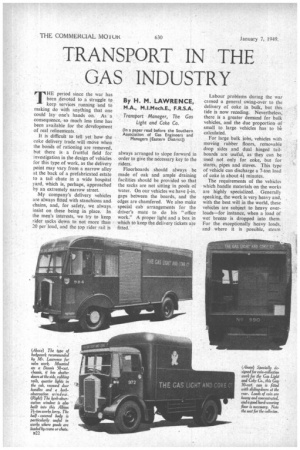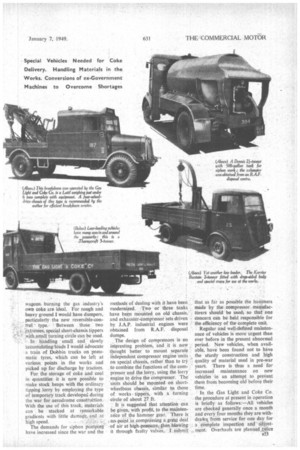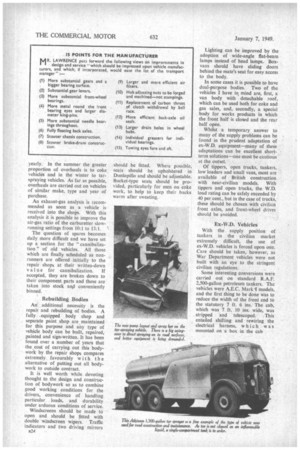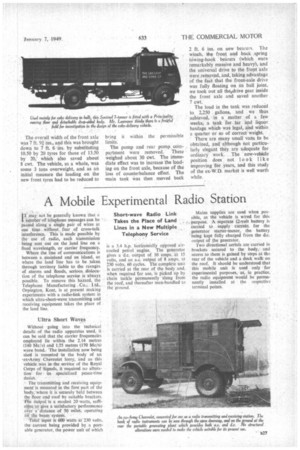TRANSPORT IN THE GAS INDUSTRY
Page 48

Page 49

Page 50

Page 53

If you've noticed an error in this article please click here to report it so we can fix it.
By H. M. LAWRENCE, M.A., M .1. M ech. E., F.R.S.A.
THE period since the war has been devoted to a struggle to keep services_ running and to making do with anything that one could lay one's hands on. As a consequence, so much less time has been available for the development of real refinements.
It is difficult to tell yet how the coke delivery trade will -mtive when the bonds of rationing are removed, but there is a fruitful field for investigation in the design of vehicles for this type of work, as the delivery point may vary from a narrow alley at the back of a prefabricated estate to a tail chute in a wide hospital yard, which is, perhaps, approached by an extremely narrow street.
-My company's delivery vehicles are always fitted with stanchions and. chains, and,. for safety, we always. insist on these being in place. In the men's interests, we try to keep rider sacks down to not more than 20 per load, and the top rider rail is always arranged to slope forward in order to give the necessary key to the riders.
Floorboards should always be made of oak and ample draining facilities should be provided so that the sacks are not sitting in pools of water. On our vehicles we have *-in. gaps between the boards, and the edges are chamfered. We also make special cab arrangements for the driver's mate to do his "office work." A proper light and a box in which to keep the delivery tickets are fitted. Labour problems during the war caused a general swing-over to the delivery of coke in bulk, but this tide is now receding. Nevertheless, there is a greater demand for bulk vehicles, and the due proportion of small to large vehicles has to be calculated.
For large bulk jobs, vehicles with moving rubber floors, removable drop sides and dual hinged tailboards are useful, as they can be used not only for coke, but for stores, pipes and stoves. This type of vehicle can discharge a 7-ton load of _coke in about 4 minutes. The requirements of the vehicles which handle materials on the works are highly specialized. Generally speaking, the work is very heavy and, with the best will in the world, these vehicles are subject to heavy overloads—for instance, when a load of wet breeze is dropped into them. For the exceptionally heavy loads, and where it is possible, steam wagons burning the gas industry's own coke are ideal. For rough and heavy ground I would have dumpers, particularly the new reversible-control type. • Between these two parenies, special short-chassis tippers with small turning circle can be used.
• In handling small and slowly accumulating loads I would advocate a train of Dobbin trucks on pneumatic tyres, which can be left at various points in the works and picked up for discharge by tractors.
For the storage of coke and coal in quantities it is now possible to make stock heaps with the ordinary tipping lorry by employing the type of temporary track developed during the war for aerodrome construttion. With the use of this track, materials can be stacked at remarkable gradients with little damage„ and at high speed.
The demands for siphon pumping have increased since the war and the methods of dealing with it have been modernized. Two or three tanks have been mounted on old chassis. and exhauster-compressor sets driven by J.A.P. industrial engines were obtained from R.A.F. disposal dumps.
The design of compressors is an interesting problem, and , it is now thought better to mount separate independent compressor engine units on special chassis, rather than to try to combine the functions of the compressor and the lorry, using the lorry engine to drive the compressor. The Units should .be mounted on shortwheelbase chassis, similar to, those of works tippers, with a turning circle of about 27 ft.
It is suggested that attention can be given, with profit, to the maintenance of the hammer gear. There is no-pointin compressing a,great deal •
of air at high-pretsure,l,thenlAowing it through faulty valves,, I submit
that as far as possible the hammers made by the compressor manufacturers should be usedj so that.one concern can be held responsible for the efficiency of the complete unit.
Regular and well-defined maintenance of vehicles is more urgent than ever before in the present abnormal period. New vehicles, when available, have been found not to have the sturdy construction and high quality of material used in pre-war years. There is thus a need for increased maintenance on new vehicles in an attempt to prevent them from becoming old before their time.
In the Gas Light and Coke Co. the procedure at present in operation is briefly as follows:—All vehicles are checked generally once a month and every four months they are withdra*n, from service for one day for a eomplete inspection and adjustment. Overhauls are planned tAyice yearly. In the summer the greater proportion of overhauls is to coke. vehicles and in the winter to tarspraying vehicles. As far as possible, overhauls are carried out on vehicles of similar make, type and year of purchase.
An exhaust-gas analysis is recommended as soon as a vehicle is received into the shops. With this analysis it is possible to improve the air-gas ratio of the carburetter slowrunning settings from 10:1 to 13:1.
The question of spares becomes daily more difficult and we have set up a section for the " cannibalization " of old vehicles. All those which are finally scheduled as nonrunners are offered initially to the repair shops at their written-down value for cannibalization. If accepted, they are broken down to their component parts and these are taken into stock arkd conveniently binned.
Rebuilding Bodies
An additional necessity is the repair and rebuilding of bodies. A fully .equipped body shop and separate paint shop are maintained for this purpose and any type of vehicle body can be built, repaired, painted and sign-written. It has been found over a number of years that the,cost of carrying out this bodywork by the repair shops compares extremely favourably with the alternative of putting out all bodywork to outside contract.
It is well worth while devoting thought to the design and construction of bodywork so as to combine good working conditions for the drivers, convenience of handling particular loads, and durability under arduous conditions of service.
Windscreens should be made to open and should be fitted with double windscreen wipers. Traffic indicators and two driving mirrors should be fitted. Where possible, seats should be upholstered in Dunlopillo and should be adjustable. Bucket-type seats should be provided, particularly for men on coke work, to help to keep their backs warm after sweating.
Lighting can be improved by the adoption of wide-angle flat-beam lamps instead of head lamps. Boxvans should have sliding doors behind the mate's seat for easy access to the body.
In some cases it is possible to have dual-purpose bodies. Two of the vehicles I have in mind are, first, a van body with detachable roof, which can be used both for coke and gas sales, and, secondly, a special body for works products in which the front half is closed and the rear half open.
Whilst a temporary answer to many of the supply problems can be found in the prudent adaptation of ex-W.D. equipment—many of these adaptations can be excellent shortterm solutions—one must be cautious at the outset.
Of tippers, open trucks, tankers, low loaders and small vans, most are available of British construction with near-civilian models. With tippers and open trucks, the W.D. load rating can be safely exceeded by 40 per cent., but in the case of trucks, these should be chosen with civilian front axles, and front-wheel drives should be avoided_
Ex-W.D. Vehicles
With the supply position of tankers in the civilian market extremely difficult, the use of ex-W.D. vehicles is forced upon one. Care should be taken, however, as War Department vehicles were not built with an eye to the stringent civilian regulations.
Some interesting conversions were carried out on standard R.A.F. 2,500-gallon petroleum tankers. The vehicles were A.E.C. Mark'l models, and the first thing to be done was to reduce the width of the front end to the statutory 7 ft. 6 ins. The cab, which was 7 ft. 10 ins, wide, was stripped and telescoped. This entailed shifting and rewiring the electrical harness, which was mounted on a box in the cab The overall width of the front axle was 7 ft. 91 ins., and this was brought down to 7 ft. 6.ins. by substituting 10.50 by 20 tyres for those of 13.50 by 20,' which also saved about 8 cwt. The vehicle, as a whole, was some 3 tons overweight, and as an initial measure the loading on the new front tyres had to be reduced to bring it within the permissible limits.
The pump and rear pump coinpartment were removed. These weighed about 30 cwt. The immediate effect was to increase the loading on the front axle, because of the loss of counterbalance effect. The main tank was then moved back 2 ft. 6 ins, on new bearers. The winch, the front and back spring tOwing-hook bearers (which were remarkably massive and heavy), and the universal drive to the front axle were removed, and, taking advantage of the fact that the front-axle drive was fully floating on its ball joint. we took out all theydrive gear inside the front axle and saved another 7 cwt.
The load in the tank was reduced to 2,250 gallons, and we thus achieved, in a matter of a few weeks, a tank for tar and liquor haulage which was legal, and within a quarter or so of correct weight.
There are many small vans to be obtained, and although not particularly elegant they are adequate for ordinary work. The new-vehicle position does not look like knproving for years, and this study of the ex-W.D. market is well worth
while.




















































































